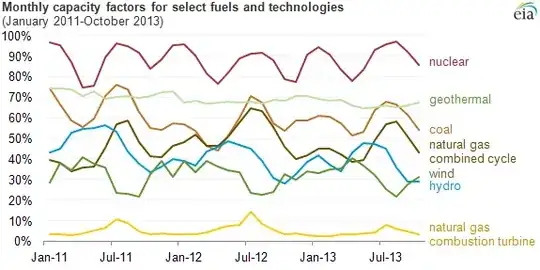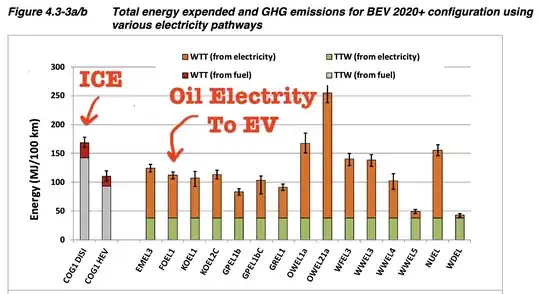tl;dr: The claim is false. The claim is that there would need to be six times as much electric generation, but if all cars in 2019 had been electric, only 1.43 times (43%) more generation would have been needed to power them all. This was most likely within the capacity of the existing power system.
Internal combustion engine vehicle (ICEV) statistics, 2019
The claim is about the present day, but for this analysis I'm going to use 2019 data, the last full year before the pandemic started.
Per the U.S. Federal Highway Administration, in 2019 there were 276,491,174 registered vehicles in the U.S. (including both passenger and freight vehicles) which traveled a total of 3,261,772,000,000 miles.
Less than 2 million of these were EVs (source), which I'll treat as a rounding error. The table down below breaks them down by vehicle type. Buses and motorcycles are listed separately for some reason, but I lumped them together as "other" for completeness.
Electric vehicle (EV) data
Per the Electric Vehicle Database, the average passenger EV has a battery capacity of 59.3 kWh and a range of 196 miles (315 km).
Capacity estimates are harder to come by for heavy duty vehicles, as there aren't many of these on the road yet. However this recent Autoweek article looking at freight trucks mentions a range of capacities from 220 to 475 kWh, with a corresponding range of ranges from 125 to 250 miles. Using the data from the FHA, the average heavy duty vehicle would need to travel less than 100 miles per weekday:
300,050,000,000 mi / 13,085,643 vehicles / 261 weekdays = 88 mi/weekday/per vehicle
...so I'll use the low end of the battery capacity range.
The charging efficiency is also needed, as the amount of energy the vehicle uses to drive is less than what is required to charge it. 85% charging efficiency is a conservative estimate from Car and Driver.
How much energy would be needed?
Combining all the data, and calculating the total energy that would have been needed in 2019 to power these EVs:
| Item |
Light duty |
Heavy duty |
Other |
All vehicles |
| Quantity |
253,814,184 |
13,085,643 |
9,591,347 |
276,491,174 |
| Miles per year |
2,924,053,000,000 |
300,050,000,000 |
37,669,000,000 |
3,261,772,000,000 |
| Battery (kWh) |
59.3 |
220 |
220 |
na |
| Charger efficiency |
85% |
85% |
85% |
85% |
| Range (miles) |
196 |
125 |
125 |
na |
| Total GWh |
1,040,794 |
621,280 |
77,997 |
1,740,071 |
The energy is calculated as follows:
( miles traveled [mi] / range [mi] ) x ( capacity [kWh] / efficiency [%] ) = energy [kWh]
For light duty vehicles the efficiency works out to 0.36 kWh/mi (95 MPGe), or slightly worse than the U.S. Alternative Fuel Data Center's 2015 estimate of 0.32 kWh/mi (105 MPGe) for the fleet of EVs on the road at that time.
Assuming losses of 5% in transmission and distrubtion, the actual amount of generation required would have been 1,827,075 GWh.
Total electric generation in the U.S. in 2019 was 4,266,488 GWh per the U.S. Energy Information Administration, meaning that a total of 6,093,563 GWh would have been needed to meet the EV demand in addition to the existing demand.
Thus, if every vehicle in 2019 had been an EV, only 1.43 times (43%) more electric energy would have been needed, not six times (500%) more.
Going a bit beyond the scope of the question...
Was that much energy feasible?
The generation at any given time is matched to the load, so the real question is whether the higher load could have been met, which is a function of total generator capacity.
Ignoring intermittent resources such as solar, wind, and pumped hydro, the total dispatchable capacity in 2019 was 917 GW, with a theoretical ability to generate a total of 8,033,064 GWh (assuming 24x7 operation). This is a conservative estimate using the net summer capacity, which is lower as thermal plants (coal, natural gas, and nuclear) are less efficient when ambient temperatures are higher.
The intermittent energy sources generated 483,826 GWh in 2019, meaning the dispatchable sources would have needed to generate 6,093,563 - 483,826 = 5,609,737 GWh total. This equates to keeping them running 69.8% of the time, compared to 47.1% without the EV load, or an extra 5.5 hours every day.
Is it feasible to run these power sources 70% of the time? In 2014, the EIA began publishing capacity factor data, and produced this chart:

Nuclear, coal, and natural gas -- the key technologies used in the U.S. to generate power on demand -- do appear capable of operating 70% of the time at least based on the monthly data. However, this would likely be costly and challenging due to the reduced time for maintenance and upkeep.
And of course, none of this considers fuel availability, but at the very least there'd be lots of extra gasoline and diesel available to run power plants, and many plants in the U.S. can actually switch from natural gas to petroleum.
What about charging all of those batteries?
There is some discussion in the comments about the challenge of electric demand for charging -- i.e., if everyone plugs in their EV to charge at the same time, could the grid handle it? Probably not, but as long as we're magically replacing all cars in 2019 with EVs, why not magically supply them with smart chargers as well? The average vehicle drove about 32 miles per day; with a (magically supplied) level 2 charger, that would require an hour or less to charge each day. Smart chargers which monitor price signals and utility commands could easily ensure all vehicles were fully charged when needed without overloading the grid.

